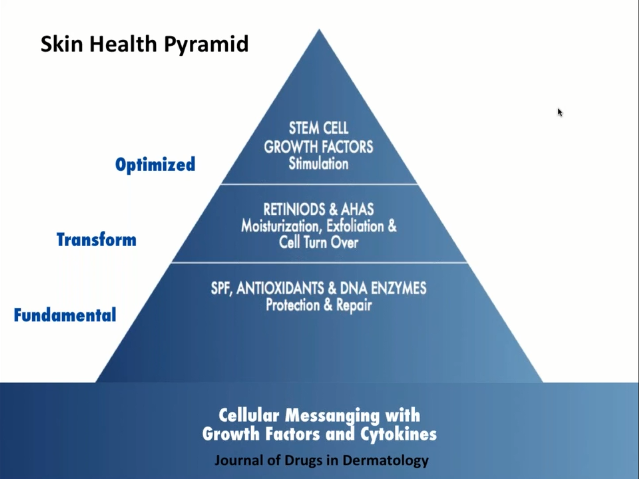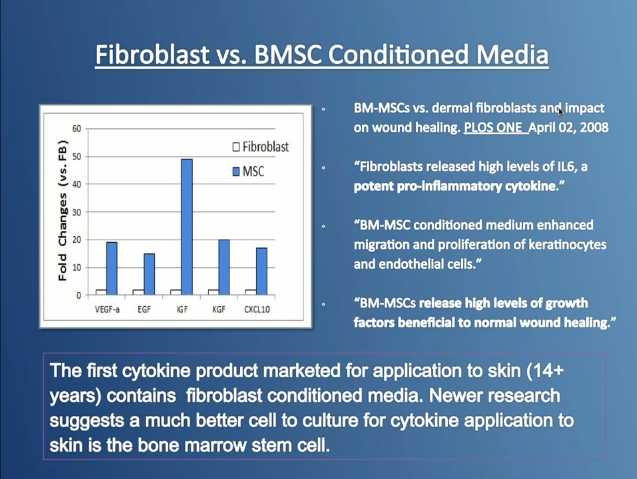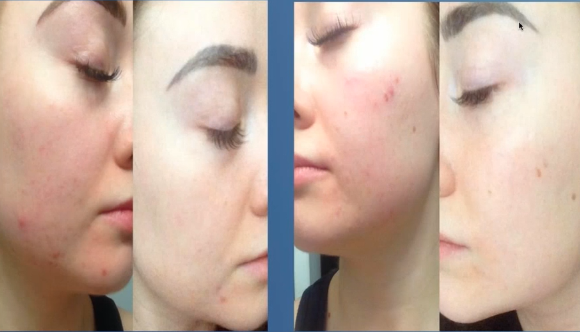If there is a Skin Care Product that is the “Holy Grail,” this is it!
In the Skin Care Universe, there are ample skincare product ingredients that provide visible benefits to your skin (and are absolutely worth using). This blog, however, is about something far beyond that.
First of all, did you know there is a “Skin Health Pyramid?” There is! The original “food pyramid” illustrated the importance of veggies and protein, and in a similar way…the Skin Health Pyramid ranks the most beneficial skincare ingredients! The pyramid was researched by the Journal of Drugs in Dermatology (a peer-reviewed, MEDLINE®/PubMed® indexed journal for the dermatology community). This Journal is one of the gold standards for information in the field: high integrity, high quality, scientifically sound content covering topics including drugs, devices and methods in relation to cutting-edge skin care. (Don’t panic about the word “drugs” here…we’re talking about active skincare product ingredients with measured, proven ability to improve you skin’s appearance.)
Skin Health Pyramid
(Stem cell growth factors at the top!)
At the Top of the Pyramid? Stem Cell Growth Factors.
Being placed at the top of the Skin Health Pyramid indicates the ability to initiate the greatest positive change in your skin. So! Why are stem cells placed at the very top of the pyramid? (Only certain kinds of stem cells, to be more specific…more on that shortly.) The simple answer: Ability! Far beyond merely supporting skin, stem cells actually direct your own skin cells to heal and regenerate in a healthier way. This can powerfully change the progressive journey of worsening skin damage…into a pilgrimage of ongoing healing of existing skin damage—and actual prevention of future skin damage. (By skin damage, we’re talking about such unpleasantries as uneven pigmentation, lines, wrinkles, sagging, enlarged pores and redness.) Amazing, yes?! The use of (worthy!) stem cell products in your skin care routine can definitely create naturally healthier and more youthful looking skin.
One more reason why stem cells are Queens of the Skin Health Pyramid? Stem cells emit something called growth factors,* which improve the performance of absolutely everything else you place on your skin. (*Growth Factor science: a growth factor is a type of “cytokine.” A cytokine is a type of protein that’s integral to cell signaling…which is how stem cells communicate with skin cells, teaching your skin how to behave more healthily and youthfully.) In short, growth factors are important messenger proteins that are directed by stem cells. Pro Tip: layer a viable stem cell product under an already-good skincare product to make it work radically better! Voila!
You may have tried some kind of “stem cell” product already and were less than impressed—there’s an excellent reason for that! Keep reading!
The number one position of stem cells on the Skin Health Pyramid means they have the most power to improve the health and appearance of your skin.
In the spirit of education-and-fun, let’s quickly go over the rest of the Pyramid: just below stem cells in a solid number two position are products that support healthy cell turnover: retinoids (vitamin A derivatives such as retinol or retin A), AHAs (alphahydroxy acids, often derived from fruits or plants) and quality moisturizing ingredients. And the foundation of the Pyramid? Non-negotiable skincare basics like antioxidants and sun protection.
Stem Cells = Natural Ability to Heal
Stem cell science is couched within the field of knowledge known as regenerative medicine: the exploration of the body’s natural ability to repair tissue and heal disease.
Let’s dissolve the shroud of mystery surrounding stem cell science and discover a few treasures: which type of stem cell most rejuvenates our skin, which type is a neutral “dud” …and which type actually works against us. Read on!
What is a Stem Cell?
A stem cell is a cell that can replicate itself, or differentiate (change) into different types of tissue. Stem cells are deeply complex, incredibly powerful and intelligent.
What the right kind of growth factor signaling can do…
Before and After using the AnteAGE Serum and Accelerator (which are both replete with bone marrow derived stem cell growth factors)
For natural, powerful healing…Human Bone Marrow Stem Cells are simply the best (better than all the rest)!
There are many types of stem cells in the body, but the “hero” of them all? The bone marrow stem cell. This stem cell is—by far—the most intelligent, mobile and powerful of all stem cells. Think for a moment about what happens when someone receives a bone marrow transplant: the new, healthy bone marrow stem cells conduct a symphony of healing throughout the receiver’s entire body. Donor stem cells rewire the receiver’s blood/immune system, bringing healthy cellular activity to replace diseased activity. Bone marrow stem cells are the only stem cells used in the medical field to heal disease, as bone marrow stem cells control and repair healing everywhere in the entire body.
Bone marrow stem cells are also the only stem cells that are “highly mobile.” This means they originate in the marrow of our bones, but travel throughout the body searching for injuries to heal. They restore, repair and powerfully reduce inflammation. And it’s worth repeating: because bone marrow stem cells control healing in all tissue…this includes our skin.
Remember the “growth factors” mentioned above? Their benefits keep coming. Another (not insignificant!) bonus that human bone marrow stem cells (lush with growth factors!) bring to skincare products is the backing of science. Scientific studies have repeatedly, conclusively proven that bone marrow stem cells are safe and bring a plethora of benefits to our skin. Unlike wacky skincare fads in the anti-aging arena that have no scientifically proven benefit, are potentially harmful and even radically expensive (such as “young blood” transfusions, one example of quackery among many)…human-derived bone marrow stem cells have science, safety, ethics and results on their side.
How do they do it?
Science Supported
Growth factors from bone marrow stem cells improve skin health.
A stem cell can directly replace a diseased, damaged or unhealthy cell by attaching to that cell…instigating healing…and then commanding the formerly-wounded cell to replicate into a healthier version of itself. (The best kind of magic—taa daaa!)
Stem cells also use something called “paracrine signaling.” This process involves a stem cell changing a damaged cell by sending it a message—as opposed to attaching to it. (When bone marrow stem cells find injury, they remain at the injury site and act as intelligent healing over-seers, secreting potent cytokines. A Mission Control for skin healing!)
A cytokine will travel to the diseased/damaged cell carrying a very powerful coded message, causing the injured cell to listen up and do what it's told to do—which means immediately behaving in a healthier way. (In the skin care world, this means our skin starts looking better, as our skin damage starts to heal.)
Apart from red blood cells, all cells that are nucleated (have nucleuses) communicate with each other. The nucleus of a cell contains DNA—-our genetic material—which controls and directs all cell activity. Protein messages from cytokines bring about biological changes, essentially telling our cells how to behave differently. Healthier. (Something quite wondrous to consider: a full symphony of cellular communication is happening in our bodies at all times! It’s incredible to think that we're able to fine-tune specific messages to create healthier skin!)
Why does skin damage occur in the first place?
So many things diminish with age…the amount of hyauluronic acid naturally present in our skin is one example. Unfortunately, our bodies also produce fewer stem cells as we grow older, resulting in slower and increasingly imperfect skin healing. Gradual, advancing skin damage is the result. (Fun fact…by the time we are about 50 years old, we only have about two percent-TWO PERCENT!!!- of the healing stem cell activity left from the generous plethora that we were born with. No wonder skin healing slows down as we age.)
Here’s the scientific definition of aging: “Progressive accumulation of damage at the cellular and molecular level.” The real-world definition? Our skin looks less vibrant and elastic over time! A lifetime of accumulating little damages (tiny injuries, really) gets etched into our cells. This ultimately re-shapes our faces, producing the hallmark signs of aging we’d all love to halt or reverse: lines, wrinkles, sagging, hyperpigmentation, enlarged pores, redness and so on.
Two of the biggest causes of this damage? Ultraviolet light—mostly from the sun or a tanning bed—and environmental pollution. Other factors include smoking, sustained high stress levels, ongoing lack of sleep, chronically poor diet (such as too much sugar, too much alcohol, too many foods cooked at high heat until they blacken…and not enough fresh vegetables, greens, fruits, roots, squash, fresh herbs…), etc. Surprisingly, skincare products/treatments causing chronic inflammation (some actually do!) are a contributing factor; more on this later.
How does this damage show up in our skin?
Cumulative damage as described above thins the top layer of the epidermis (called the “stratum corneum”), causing your skin’s defense capability to weaken by compromising what’s called “the microbiome”- your skin’s natural layer of protection. This triggers dehydration and increases vulnerability, leaving skin more sensitive and irritated.
The “dermal/epidermal junction” is the layer just beneath the epidermis. Once the epidermis is damaged this deep layer flattens out, leaving less space for nutrients to pass freely from dermis-to-epidermis. As a result this area becomes more fragile, less resilient, and more susceptible to separation…which eventually results in what we all more commonly understand as sagging skin!
And things get even deeper! Just beneath that dermal/epidermal junction is the layer called the “dermis.” Here collagen and elastin (two crucial proteins in keeping your skin firm and smooth) start to degrade…leading to (eek!) “dermal collapse.” Sounds bad? Yes! Worse still? All of this contributes to melanocytes (melanin producers that give our skin its color) unevenly distributing melanin to neighboring keranocytes (specialized skin cells), which leads to hyperpigmentation (skin areas that are too dark) or hypopigmentation (skin areas that are too light). Yikes!
What is the remedy?
To reverse this harrowing state of affairs, we must restock our storehouse of anti-inflammatory messenger proteins (growth factors from bone marrow stem cells—but you already know this by now!). What you may not know is that with topically applied growth factors, you must have a physiological balance. This means that the right messaging must be given to your skin cells, that the messaging must be anti-inflammatory, and that it must be delivered to your skin in a way that can be understood and utilized. Tall order—and help has arrived (read on).
Anti-inflammatory
The right balance of protein will have an anti-inflammatory, healing action for skin.
Topically Applied Growth Factors must be able to communicate with your skin cells, and must be anti-inflammatory!
Something called the “net pattern” (a framework of information) of stem cells/growth factors determines whether your stem cell product will be inflammatory or anti-inflammatory. The key? A specific portfolio of proteins present in your skincare product. Repeating here…with topically applied growth factors, you must have a physiological balance!
Epidermal growth factors (a “buzzy” term in the skincare world) should never be applied on their own. Here’s why: if they are presented in isolation—which is not a physiologically balanced protein portfolio—they can potentially increase the expression (messaging) of cell activity you don’t want to replicate. Thank you, next!
It’s worth noting that fibroblast cells (another big “buzzword” in the skin care world) are not stem cells. Fibroblast cells take orders from bone marrow stem cells, they do not give orders. And, fibroblast cells are not nearly as robust as bone marrow stem cells (more on this soon…stay with me!).
How do we know if a “Stem Cell” or “Growth Factor” skincare product is any good?
While the mighty bone marrow stem cell is the best option for improving our skin, many other stem cell options exist in the skin care world. Let’s take a detailed look...
Adipose/Fat Stem Cells (and why we never want to use these in skin care):
Skincare products that utilize adipose stem cells (stem cells from fat tissue) are typically obtained from…liposuction waste! (Yes, this is exactly what you’re afraid it might be…it’s fat that was suctioned from people who have liposuction performed!). Liposuction waste is very rightly considered to be medical waste. (And also, just…ewww!)
While this is a cheap source of human stem cells, there is a big problem: fat stem cells have ZERO role in tissue healing. These cells can only do one task—make more fat. Sadly, they are also highly inflammatory!
Liposuction recipients are typically overweight individuals over the age of fifty. This becomes noteworthy because people who are overweight or obese have fat stem cells that are even more inflammatory. (By far, the most robust stem cells come from younger, healthy adults.)
Using fat stem cells can have a very undesirable inflammatory effect. Here’s the even-stickier catch: using products with fat stem cells can make skin temporarily look better. But here, “better” is due to big inflammation! Inflammation causes temporary swelling/water retention, making the skin look plumper for a time. This is in the “naughty column” for sure! The long-term effect of inflammation is undisputed—it causes and accelerates both damage and aging for your skin.
If you read the words “human stem cell conditioned media” on a skincare product label, it’s likely derived from adipose tissue (fat), as skincare companies are not required to disclose what type of stem cells are used. As fat stem cells gain more notoriety for being highly inflammatory, skincare companies that use fat stem cells will likely minimize that fact by using this more generic term—and, now YOU know.
Cell Lysates
Cell lysates…this is the name of a process for chemically stimulating cells to multiply. The process includes freezing, thawing, and breaking cells apart into cell fragments to attempt to create signaling proteins. The process is not natural. Cell fragments (also called “cellular waste” or “cellular debris”) are what your body naturally dumps into your lymph system for removal. Cell lysates are not tuned to skin regeneration. These chemically stimulated cells are often called “parthenogenetic stem cells,” which means cells that do not exist in nature. They absolutely cannot provide the physiological balance of protein your skin requires for regeneration.
Fibroblast cells?
Fibroblast cells are not bone marrow stem cells (BMSC).
Fibroblast Cells
Fibroblast cells are not bone marrow stem cells, and there are many, many reasons why your skin will thank you if you stay FAR away from products containing them! While they have an important part in skin regeneration, they are extremely weak: fibroblast stem cells produce about 1/15th to 1/50th of the amount of bone marrow stem cell growth factor production. Even if math fractions are not your thing, you know this is a paltry and pathetic amount. Also, the type of growth factor fibroblast cells produce tends to teeter on the inflammatory side (an example: interleukin 6). Finally—as mentioned earlier, and worth repeating—fibroblast cells take orders from bone marrow stem cells, they do not give orders. Fibroblast cells must be told what to do in order to act. The bone marrow stem cells alone have the ability to orchestrate robust skin healing. As an extremely relevant side note, fibroblast stem cells are used in the infamous “foreskin facials” or “penis facials” that you have probably heard/read celebrities gushing about. If you were unaware of those until now, YES, they are “a thing.” The signaling proteins are derived from the foreskin waste of circumcised infants. Foreskin stem cells are nowhere near as effective as bone marrow stem cells…and foreskin in particular is a weak (apologies, gentlemen!) producer of stem cells—some of which also happen to be seriously pro-inflammatory. Run away, far and fast!
Plant Stem Cells
Hello out there…?
Plant Stem Cells
Plant stem cells exist in “meristems”: meristems are the closest plant equivalent of human stem cells, and are the region of cells capable of division and growth in plants. The behavior of meristems is dictated by plant hormones. To “culture” the meristems, they’re extracted from the plant (“culture” means to prepare cells for insertion into active skincare formulations). The plant meristems—plant “stem cells”—are under the control of the plant itself. So! Once you remove those cells from the plant, they have no way to communicate with human skin cells. More significantly: they do not have any way to communicate at all. Sadly, meristems cannot function once they have been removed from the plant; they essentially lose their “voice.” And even if they could communicate, what could they tell your human skin cells to do? Grow big, green leaves? Grow spiraling, vine-y tendrils?
Plant ingredients absolutely do have high value in skincare products (they’re antioxidant rich, are chock-full of beneficial nutrition, and can support skin health in countless ways). However, when meristems are removed from the plant, no amount of culturing in a lab can remedy their inability to talk to human cells, because as of this writing…it is physiologically impossible for plant stem cells to communicate with human skin cells. Plant stem cells simply can’t direct your skin cells the way human derived bone marrow stem cells can.
Quick side note: You may be surprised to learn that I absolutely love the Grape Stem Cell Serum and the Rich Grape Stem Cell Moisturizer. Both are chock-full of grape seed-rich ingredients, which are incredibly high in antioxidants, supportive of your skin’s collagen and elastin integrity, and calming enough for nearly all skin types. HOWEVER! As you know very well by now, the “stem cell” part is just a ruse! “Grape stem cells” cannot communicate with or influence your human skin cells. I wish I could rename these products and remove the words “stem cell,” because they’re great products for what they can actually do—and the “stem cell” part is misleading. (If I were in charge of the world! Ah, well…working on it.)
Platelet Rich Plasma (PRP) Facial or the “Vampire Facial”
In this treatment, blood is removed from the client, and the plasma in the blood is separated from the red blood cells in a centrifuge before being applied to the skin or injected back into the skin (…which makes the idea of actually being bitten by a vampire sound tame or dull by comparison). This separated blood “concoction” has a high amount of molecules that produce growth factors…HOWEVER! Platelet Rich Plasma (PRP) has a highly inflammatory protein portfolio. Let me repeat that for you: PRP has a highly inflammatory protein portfolio! Studies have indicated that PRP, most often done in conjunction with micro-needling, adds NO additional benefits to micro-needling alone. But, it does add the potential harm of inflammation. (Yipee! NOT!)
How do stem cells get “cultured” (activated so they benefit your skin!) in a skincare product?
All stem cell skincare product makers will “culture” the stem cells they utilize. “Culturing” means the stem cells are extracted and bathed in rich nutrition (sometimes called a stem cell “broth” or stem cell “media”) to create the perfect environment in which the stem cells can multiply.
The bone marrow stem cells in the AnteAGE product are taken a step farther in the culturing process. Tiny spherical pearls are added, allowing three-dimensional growth to occur. The culturing stem cells are placed in an environment that mimics their native environment (in regard to oxygen levels, etc.) to encourage optimal growth factor production. When the culturing process is complete, stem cells are separated from the nutrition and newly created protein (cytokine), and it is only the new protein (meaning: the cytokine growth factor that has the proper messaging for your skin cell receptor) that is actually placed in your skincare product. No actual bone marrow stem cells or stem cell parts are in your skincare products, when all is said and done.
Remember, the ideal stem cell culture is made from human bone marrow stem cells. (Repeating here!) Bone marrow stem cells control and repair healing everywhere in your body—and this includes your skin. This is the exact signaling your skin cells need to heal and repair both aging damage and general skin damage.
Where do the Human Bone Marrow Stem Cells come from that are used in AnteAGE skincare?
The AnteAGE stem cells come from established bone marrow medical centers! Bone marrow stem cell donors are sourced from carefully screened volunteers. These voluntary (and paid) bone marrow donors are typically fit, young and female…as females produce more stem cells. (That’s right, ladies!) All donors are put through a rigorous health screening process before they’re allowed to donate. Young, healthy, adult, female bone marrow stem cells are metabolically active, replicate at a more rapid rate, produce greater quantities of cytokines in culture and are very anti-inflammatory…so they are the only type utilized by AnteAGE.
Reducing chronic inflammation…
…is pro healing.
Why is avoiding prolonged inflammation such a big deal?
Inflammation is your body’s complex biological/chemical/cellular response to trauma, injury or an infectious substance. It’s the “second stage” of wound healing: short-term inflammation is how our body can recover from infections. However! Prolonged or chronic inflammation is very different, and is anti-healing. This kind of inflammation causes permanent collagen damage. (As mentioned earlier, ultraviolet rays and environmental pollution cause prolonged inflammation as well.)
This is key: if a skincare product or ingredient is going to be truly anti-aging, it must be anti-inflammatory at the cellular level.
Collagen is one of the most important structures in the dermis in relation to your skin’s appearance. Collagen’s health, resilience and flexibility is made possible by swift, intelligent healing with minimal inflammation. Chronic inflammation leads to poorly connected collagen, which causes damaged collagen production.
In the presence of inflammation, new collagen tends to form unhealthily, causing pigment issues (where skin color is too dark/light) as well as disfigurement—due to the uneven way this type of collagen is produced.
Acute, temporary inflammation is okay if it must occur (remember, inflammation is your body’s biological response to injury and is the “second stage” of wound healing), as long as it’s short-and-sweet, controlled and assisted by daily skincare products that mitigate the inflammation.
Pro-tip: Make sure what you apply to your skin every day is as anti-inflammatory as possible.
Daily Anti-inflammatory skin care…
…creates healthy changes in skin.
What’s in the AnteAGE Serum and AnteAGE Accelerator?
The AnteAGE Serum is water-based for hydration, has lipids for exceptional absorption, and is absolutely packed with active, viable cytokines derived from human, bone marrow stem cells. Other clinically proven, undisputed, all-star ingredients include:
Niacinamide (vitamin B3): improves skin moisture, softness, suppleness, reduces trans-epidermal-water-loss (TDWL), boosts ceremides (which help to restore and strengthen your skin’s natural microbiome), increases keratin (keratin = an essential protein that protects your skin), and promotes collagen secretion (secretion is vital to the heathy growth and development of collagen).
Carnosine: defends against glycation (crosslinked collagen that appears as wrinkled, damaged skin) and is a powerful antioxidant (antioxidants protect skin from free radical damage).
Palmitoyl Ogligopeptide: hugely beneficial peptide that helps with our skin’s natural collagen and hyaluronic acid production, provides mild UV protection and duplicates the benefits of retinoic acid (retinol and retin A) without the potential skin irritation associated with retinoic acid.
Palmitoyl Tetrspeptide 7: another hugely beneficial peptide complex that’s instrumental in stimulating your skin’s natural collagen and hyaluronic acid production.
Catechins and Flavonoids: molecules that promote the extracellular matrix and increase cell proliferation, as well as provide potent antioxidant support.
Bakuchiol
A plant molecule that activates cellular retinoic acid receptors without the classic irritation of traditional retinol, supports collagen synthesis, and provides an anti-acne and anti-inflammatory effect...and works beautifully with the cytokines in the AnteAGE Accelerator.
The AnteAGE Accelerator is a performance driven treatment rich in powerful moisturizers and revitalizing actives to deeply restore and nourish your skin while providing unparalleled rejuvenation with a team science-backed all-stars:
Ceramides and Phospholipids: support microbiome homeostasis, and helps skin maintain moisture levels.
Stem Cytokines: bio-signals harvested from the cells responsible for commanding and controlling tissue healing (human bone marrow stem cells).
Bakuchiol: plant molecule that activates cellular retinoic acid receptors without the classic irritation of traditional retinol, supports collagen synthesis, and provides an anti-acne and anti-inflammatory effect.
Beta Defension 3: antimicrobial peptide that supports healthy skin ecology and a strong microbiome, as well as an anti-inflammatory effect.
Iris Isoflavones: provides sun damage prevention and inflammation reduction.
Vitamin C Acetate: antioxidant.
Vitamin C Ester: antioxidant, stimulates collagen production, inhibits melanogenesis (uneven pigmentation).
Panthenol (vitamin B 5): humectant, emollient, moisturizing ability; stimulates collagen production.
Coenzyme Q10: essential in cellular energy production and potent antioxidant.
Grape Seed Extract: strong antioxidant, protects collagen, improves elasticity.
Human Bone Marrow Stem Cell Conditioned Media: derived from the only stem cell that enhances your skin’s ability to overcome UV damage.
Both the AnteAGE Serum and AnteAGE Accelerator are formulated to be safe and healthy, even for those with compromised skin and immune systems. The growth factor actives are tuned for an anti-inflammatory response, which is understood to be anti-proliferative…so they are safe even for those undergoing oncology (cancer) treatments. Oncology Spa Solutions (OSS) is the preeminent US organization for reviewing and recommending aesthetic products to be used in conjunction with oncology treatments. The AnteAGE Serum and Accelerator have been reviewed and approved by OSS.
The AnteAGE Serum and Accelerator are pregnancy- and breastfeeding-approved.
The AnteAGE Serum and Accelerator are also available in an extra strength MD version.
You can also receive a professional-grade treatment replete with AnteAGE growth factors (in an ultra potent form used in professional treatments only) called the Stem Cell Facial Treatment.
xoxo
marna
P.S. Did you notice the before-and-after pictures? They are all of people who started using the AnteAGE Serum and Accelerator. That’s it! No other treatments were given.
P.P.S How about a short and sweet recap? (I’m pretty sure I need one!) Watch this simple, brief (two minutes!) video to bring it all home.
Related Studies and Articles:
Anti-inflammatory and Anticancer Qualities of Bone Marrow Stem Cells
The Benefit of Bone Marrow Stem Cells in Skin Care
Cytokines in Regenerative Skin Care
Adipose Stem Cells and Tumor Progression
PRP, Inflammation and Microneedling
Stem Cells, Growth Factors and Inflammation
Types of Stem Cells in Skin Care
Understanding Key Differences in Stem Cells used in Skin Care
A Primer on Combined Fibroblast and Adipose Stem Cell Conditioned Media as a Skincare Ingredient
Cell Culture Derived Human Bio-signals in Skincare: Is there an Optimal Cell Type to Culture?
Topical Cytokines & Growth Factors in Anti-Aging and Aesthetic Medical Practice
Clinical Research behind AnteAGE
Pilot Study of Effectiveness of AnteAGE Serum and Accelerator
Blog written by Marna Herrington with Rich Earth Organic Skin Care Studio
Blog copy editing and polishing provided by Karen-Eileen Gordon (MsGordonLovesWriting@gmail.com)
This blog is not intended to take the place of in-person consultations with qualified skin care and health care practitioners.
This blog is for the purpose of education and fun only. All images and text in this blog are under the legal ownership of Rich Earth Organic Skin Care Studio, or permission of use has been granted for this specific blog only. Permission is not granted for this text or these images to be copied and used out of the context of this blog, or for commercial purposes. If any part of the text is quoted in an article or other blog for educational purposes, a hyperlink to this page must be included.









